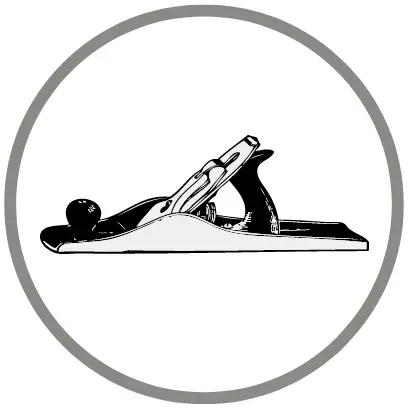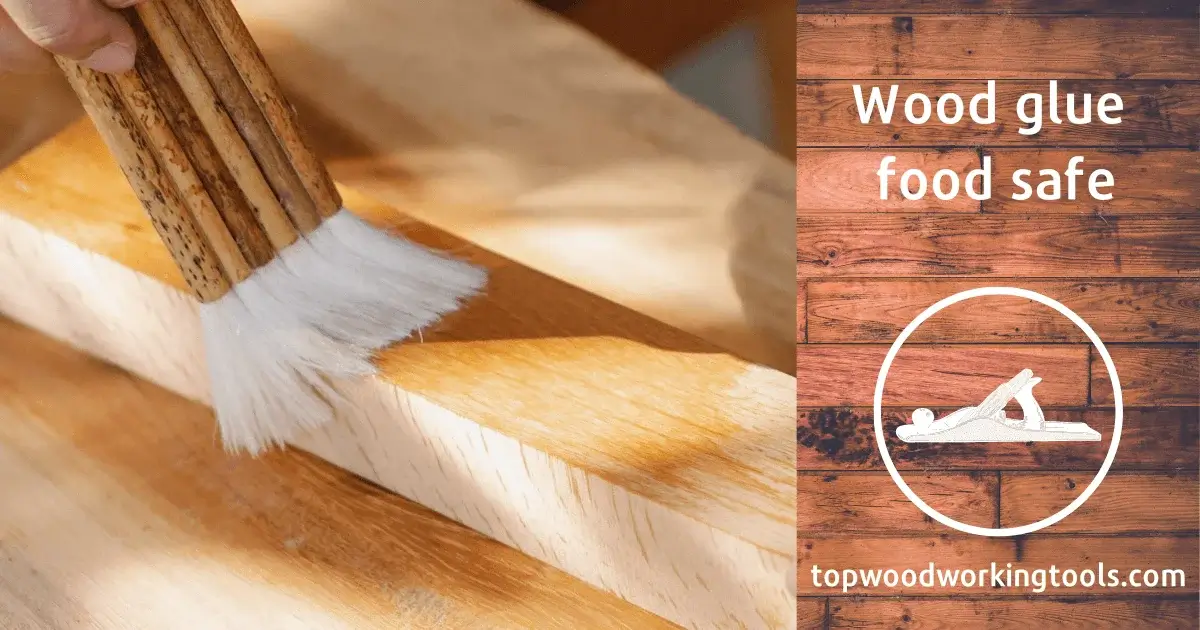Today, when there is wood glue for almost any purpose, and their variety sometimes confuses even experienced woodworkers, it is very difficult to find a decent option. And new adhesives are often made from synthetic components that make the product unsuitable for the food industry. However, there is one wood glue food safe: polyurethane.
Polyurethane is incredibly convenient and optimal because it is used for a variety of applications, including outdoor work. In this article, we will look at the best polyurethane options that are ground up for exterior work. However, first, to get up to speed you need to know what this wood glue is.
You have to understand that has to go through plenty of tests before it can be mass-marketed, and that takes a lot of time. That is why the choice of food-safe glues today is not so great. If an adhesive manufacturer claims to be safe, don’t blindly believe it. Focus on adhesives that are FDA approved.
In addition to polyurethane, there are many other food adhesives, let’s get to the bottom of it! Once completely dry, Gorilla Glue is safe to food direct contact.
Contents
- 1 Food-safe adhesives: can I use them on wood?
- 2 Polyurethane: what is it?
- 3 Food-safe polyurethane: oil or water, which is better?
- 4 What is the best wood glue food safe adhesives for exterior work
- 5 What to pay attention to when choosing polyurethane for exterior work
- 6 How to treat the surface properly with polyurethane varnish
- 7 Rubbed and sprayable polyurethane
- 8 Why polyurethane is considered the best wood glue for the food industry
- 9 Can polyurethane be used for cutting boards?
- 10 What are the differences between wood glues?
- 11 Conclusions
- 12 Answers to popular questions
Food-safe adhesives: can I use them on wood?
There is a great deal of information about the different types of food-grade wood glue currently available in the public domain. In forums, woodworkers often discuss the best glues that can be used for products that interact with food in one.
Of course, there is no unequivocal answer to this question, it is rhetorical. One way or another, adhesives are harmful, and even the safest food-grade wood glue can be harmful to humans. Let’s take apart the most popular wood glues used to treat kitchen utensils.
And we should start with polyurethane, as it is often used to treat various surfaces, including cutting boards and kitchen tables. In addition to safety, the power of polyurethane is much stronger than that of PVA glue. The basic properties of polyurethane glue can be compared to superglue, which is dozens of times more toxic.
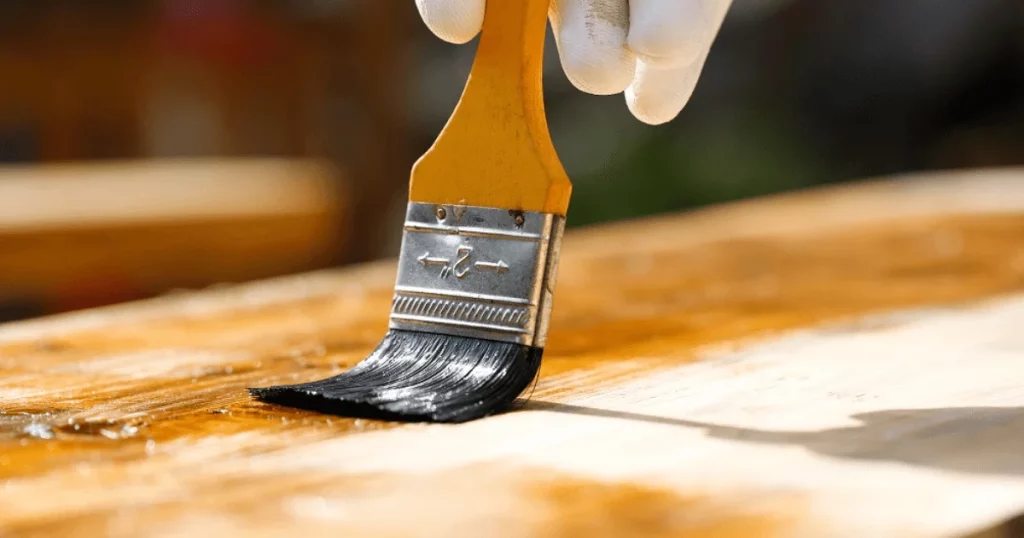
Polyurethane: what is it?
Polyurethane wood glue is a varnish that stands out for its incredible strength and durability. At its core, polyurethane consists of microscopic resin bonds. As it dries, polyurethane forms a strong bond and can bond virtually all surfaces together.
The polyurethane coating is far superior to alternative adhesives and varnishes. First, it is resistant to abrasion, and solvents, as well as water-resistant and heat-resistant. It is also worth noting that polyurethane can be used as hide glue. It’s all about its composition, which does not harm organic materials, so polyurethane is suitable as hide glue.
Polyurethane belongs to the traditional type of adhesive, which was created many years ago. However, during its existence, it has been constantly changing, as manufacturers have conducted various experiments to improve the basic characteristics of polyurethane adhesive. Therefore, many woodworkers consider polyurethane to be the best glue.
Today, polyurethane is available in a variety of colors. For example, there is a polyurethane varnish, which after complete drying creates a warm woody shade on the surface of the material. This result was the fruit of adding special oils to the polyurethane. If you do not need this feature, then just take a closer look at water-based polyurethane.
Polyurethane coating is far superior to alternative adhesives and varnishes, such as PVA glue. First, it is resistant to abrasion, solvents, and moisture. If you look objectively, polyurethane is a food-safe glue, but not all of its varieties are suitable for this purpose. I would also like to note the power of polyurethane, so a thin glue line will be enough for good gluing.
You can use polyurethane as the hide glue, plastics, and cutting boards that will later come into indirect food contact. Excess glue is easily removed with a regular blade, and its heat resistance allows you to work on difficult projects.
Food-safe polyurethane: oil or water, which is better?
The original polyurethane was oil-based and slightly toxic. Of course, it was not as dangerous as today’s best glues, but it could still cause various health problems. For this reason, manufacturers of polyurethane adhesives have developed an alternative – food-safe, water-based polyurethane.
Background information on food-safe polyurethane
Water-based food safe polyurethane glue
Once it is completely dry, water-based food-safe polyurethane becomes completely transparent, which means it retains the color of the material. If it is important to you to keep the original appearance of the product, it is better to choose water-based polyurethane.
The disadvantages of water-based polyurethane food-safe wood glue can be attributed to the need to apply several layers, as it is wet glue. However, this drawback is covered by the fast drying of varnish. Of course, compared to the oil-based polyurethane glue, the water alternative is much safer, but still should take care of good ventilation in the workplace.
Before applying and after the water-based polyurethane dries, it is necessary to treat the surface of the cutting boards. For this purpose, it is enough to use soap and water. It is better to avoid applying agents containing ammonia, as it will spoil the coating.
Oil-based polyurethane
After complete drying, oil-based polyurethane transforms the appearance of the product, adding a warm shade to it. For a complete oil-based polyurethane treatment, you only need to apply 2–3 coats, after which the coating will last for years.
During work with polyurethane, water-resistant resin on an oil base is worth taking care of the protection of respiratory organs and good ventilation of the work area. It contains a lot of volatile organic elements, which led to the ban of oil-based polyurethane in many regions of the United States.
After the application and drying of the aforementioned varnish, it is necessary to treat the surface with mineral spirits.
Water-based, oil-added polyurethane glues: This water-resistant polyurethane adds an amber coloration when drying in the same manner as its oil-based counterpart. However, its speed of drying and ability to be applied to any wood makes it the best glue for any project.
It should be noted that water-based polyurethane with the addition of oil is practically non-toxic, and ordinary water is needed to clean it. You can use nail polish remover to remove oil-based polyurethane.
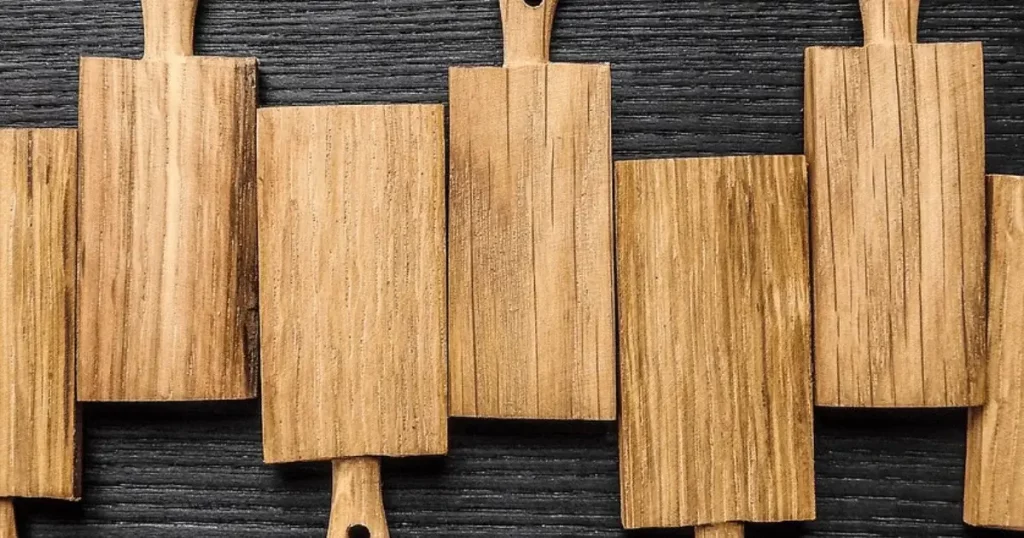
What is the best wood glue food safe adhesives for exterior work
Here we have sorted out the background information, and now let’s discuss specific polyurethanes and choose the best option for outdoor work:
ZAR Exterior Oil-Based Polyurethane (food-safe adhesives)
If you like the amber color of wood, this polyurethane is the perfect solution. It doesn’t just add a yellowish hue, it adjusts to the color of the wood and enhances it significantly. The aforementioned oil-based polyurethane provides the product with a satin finish.
In addition to its aesthetic features, ZAR Exterior water-resistant polyurethane stands out for its excellent protective properties. Today, this water-resistant polyurethane is very popular. This success is the result of the excellent combination of appearance and protective properties. A surface treated with this varnish looks stylish and fresh and becomes completely water-resistant.
If disassembling ZAR Exterior in terms of technical characteristics, there is also something to talk about. Firstly, I would like to note the reliability and durability of the aforementioned varnish. Also, this polyurethane easily withstands the influence of moisture and other elements, including ultraviolet rays.
The composition of ZAR Exterior polyurethane includes antioxidants that allow you to avoid the risk of losing the original color of the wood. That’s why many craftsmen purchase only this polyurethane permanently.
This product is completely safe for indirect food contact, as evidenced by FDA approval. It can be used for manipulation over cutting boards and other food industry products. Of course, this product is not the best glue for food-safe use, but it is quite suitable for that purpose.
RUST-OLEUM Ultimate Oil-Based Spar Urethane (food-safe adhesives)
This polyurethane water-resistant adhesive was created to reliably protect the surface of wooden products from UV rays. When the sun is constantly in contact with untreated wooden surfaces, they gradually lose their richness and color. It is suitable for any application, including the food industry, as evidenced by the FDA approval.
After complete drying, this varnish reliably protects the wood from various external irritants, for example, fungus and mold. At the same time, the aforementioned polyurethane copes well with water because it is based on oils.
Of course, this polyurethane has weaknesses. One of the most noticeable is the yellowing, which inevitably appears within a few years. In addition to the yellowing, this polyurethane varnish is slow to cure (when compared to alternatives).
Minwax Helmsman Indoor/Outdoor Spar Urethane (food-safe adhesives)
This varnish is aimed at protecting the surface from UV radiation, which means stopping the process of yellowing the wood. However, in terms of protective properties, this polyurethane lags a little behind its closest competitors. Another strong point of the aforementioned polyurethane varnish is its strong protection against UV rays; hence, the wooden surface will not peel.
Due to its unique composition, this polyurethane dries fast enough and when completely dry, its color becomes completely transparent. In the end, the wood surface becomes shiny and protected from discoloration during aging.
This polyurethane wood glue is not suitable for those craftsmen who deal with large projects with constant edits. In this case, the disadvantage flows from the plus, namely the rapid solidification speed. If the varnish has already begun to cure and run another brush over it, it can turn into damage to the entire coating, which later will have to be treated.
It is worth noting the questionable consistency of this wood glue, which is very thin and quickly absorbed into the structure of the wood. Based on this, many coats will need to be applied for a good finish, which will take a lot of time and effort. However, it is suitable for creating cutting boards and other food industry products, as it is FDA-approved.
What to pay attention to when choosing polyurethane for exterior work
Even though all polyurethanes have approximately the same composition and principle of action, they still differ. Choosing the wrong polyurethane can be confronted with a low quality of protection. In this case, some polyurethane varnishes are designed for certain tasks, but not for complex protection from external irritants.
Convenience to work with
If you have never tried to work with polyurethane before, this aspect is more important than ever for you. Using an uncomfortable polyurethane varnish can accidentally ruin both the wood and the coating. That’s why it’s best to check the method of application beforehand. This way, you can eliminate the risk of fatal mistakes.
Resistance to UV rays
An important factor is that prolonged exposure to the sun on the wood leads to yellowing and fading of the original color, and to return everything, alas, will not work. That is why you should choose oil-based polyurethane for such purposes. They have a yellowish tint, which prevents the penetration of ultraviolet.
The function of blocking the sun’s heat is not in every polyurethane. For this purpose, many varnish manufacturers add fine metal compounds to the composition, which are transparent to the human eye but reflect the sun’s rays.
Titanium dioxide compounds are most commonly used for this task. Such components absorb the sun’s rays and convert them into heat. Of course, metal bonds are not able to fully reflect ultraviolet, so you need to resort to additional methods of protection to seriously combat the sun’s rays.
Elasticity
High temperatures, high winds, and high humidity all have devastating effects on the structure of wood. As a result, the wood begins to expand or shrink. That is why before buying polyurethane, you need to double-check – whether the composition has enough oils and resins to make the wood more elastic.
If the problem of expansion and contraction of the wood product scares you, then get ready for the annual renewal of the coating. The whole point is that even specialized polyurethanes, which are designed to increase the elasticity of wood, lose their properties over time.
Renewing the old layer of polyurethane once a year is necessary to make sure that the existing layer is in good condition. In this case, it is enough to remove small debris like sand and dust. If the coating is visibly damaged, it is necessary to sand the surface and apply a layer on the cleaned wood.
Time for complete curing
This aspect is incredibly important because it affects a lot of the interaction possibilities with polyurethane. If your project is not large, and you need to finish it quickly, then, of course, buy exactly quick-drying varnish.
Service life
Smoothly, we come to the most important factor of all varnishes, including polyurethane. It is better to overpay once, getting a durable coating, than to be constantly engaged in replacing the old varnish with a new one.
How to treat the surface properly with polyurethane varnish
After you have learned all the theoretical parts about polyurethane and its varieties, you should move directly to the method of wood processing. This process is not difficult, and every beginner can cope with it. However, the processing of wood with polyurethane requires the exact requirements.
Prepare the surface of the wood
Pre-cleaning the surface of the wooden product is mandatory because otherwise, the polyurethane layer may not be completely even. First of all, to properly clean the surface of the product, it should be sanded a little with sandpaper (with a grain size greater than 200 grit).
If the wood texture is open, such as walnut, ash, or oak, before processing with polyurethane, the surface must be carefully puttied. It will end up incredibly smooth and ready for a polyurethane varnish treatment.
Once you are done sanding the surface of the product, you should remove the dust from the surface and apply the first coat. It is necessary to clean the surface before each application of the subsequent layer. For this task, you can resort to the use of wipes or a vacuum cleaner.
For the most effective cleaning of the surface of the wooden product, you can use gauze, treated with denatured alcohol (a variant for water-based polyurethane). A rag treated with mineral spirits (an option for oily polyurethane) will also work.
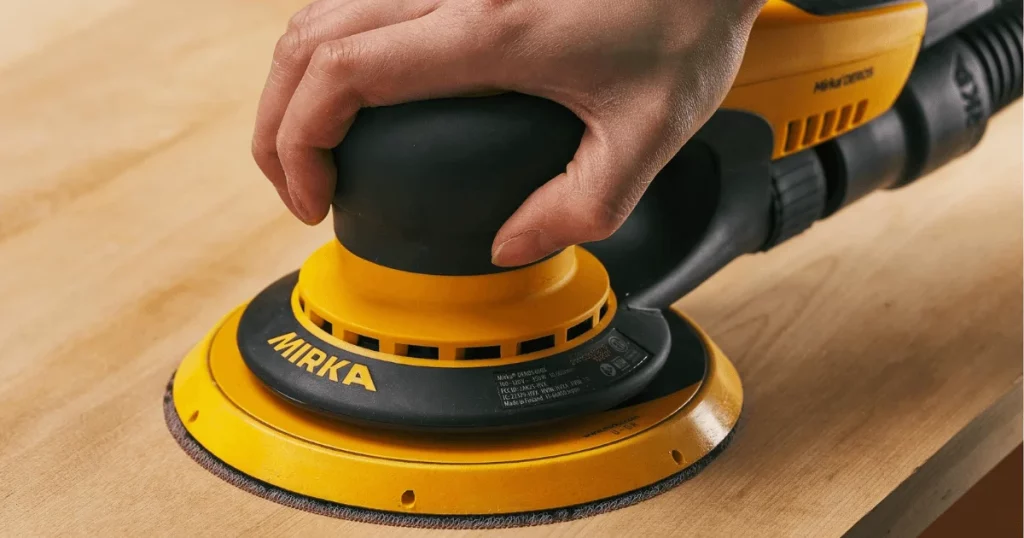
How to apply oil-based polyurethane correctly
Before applying oil-based polyurethane, the substance may be thinned with naphtha or mineral spirits. If you have the feeling that such measures are unnecessary, it is better to take advice from the manufacturer.
Diluting the oily polyurethane greatly increases the absorption capacity so that you end up with a perfect paint finish with no encrustation.
Oil-based polyurethane can be applied using a variety of methods. For example, with a special brush with soft bristles. A foam brush will also work for applying polyurethane.
It is best to avoid too cheap brushes, as their bristles are quite coarse and of poor quality. If you neglect this advice, you may be faced with the appearance of visible smears on the surface of the product. In the case of a limited budget, you can resort to the use of a foam brush, it matches perfectly a huge number of surfaces.
For difficult projects with small details and molded corners, only quality brushes with bristles should be used.
When applying oil-based polyurethane, make sure that the layer is thin enough. Otherwise, visible air bubbles may form in the varnish, which greatly impairs the final appearance of the product.
The technique of applying polyurethane on a wooden surface is quite simple. When applying, make long and straight strokes. Make sure not to miss any area, as even a small untreated fragment reduces the effect of the varnish to nothing. It is important to apply polyurethane parallel to the texture of the wood.
After the first layer dries completely, it is necessary to sand it a little. For this task, ordinary sandpaper (320 grit) will do. Polyurethane varnish is easy to sand, so it is important not to overdo it. Sanding too hard will ruin the polyurethane layer and sometimes the surface of the material.
Then wipe the surface of the first layer of polyurethane and proceed with the next one. You can clean the polished layer of lacquer with a usual vacuum cleaner or a cloth.
Apply one layer at a time before sanding and cleaning the previous layers. For a minimum level of protection, it is advisable to apply 2 coats, but this will not be enough for those products that are constantly used for various purposes. You will need at least 3 coats of polyurethane varnish to protect the surface of the product from moisture.
After each coat, you will notice the surface smoothing out. Once you are finished with the last coat, steel wool #0000 is recommended to clean it. It will smooth out the coating and make it shinier. Finally, simply treat the surface with a paste wax and admire the work done.
How to apply water-based polyurethane properly
In its essence, the application of water-based polyurethane is almost completely identical to the application of varnish based on oils. For an even finish with polyurethane, usually use a rag, a thin brush, or a foam pad. It is important to pay attention to the application method because wood should be treated with polyurethane in the direction of the texture.
Avoid thick layers of polyurethane, as this can encourage the wood’s texture to expand.
If there are noticeable oil stains on the wood surface, the water-based polyurethane will not be able to bond to it properly. That is why before applying a water-based varnish, it is best to “rough up” a bit the problematic fragment of the product. Synthetic steel wool is suitable for this purpose.
Once you are finished with the application of the first coat, you need to wait a little while until it dries. After the first layer of polyurethane dries completely, you can start applying the second layer.
In the case of water-based polyurethane, you do not need to sand the layers, but it is best to double-check the advice from the manufacturer of the lacquer.
If you are treating a product that is not subjected to strong physical impacts, most likely 3–4 coats will suffice. However, in other situations, you need 4–5 coats to protect the surface reliably.
Food-safe wood glue must have a special composition, which has only organic components. Water-based polyurethane is on the list of food-safe wood glue. Its oil counterpart cannot boast the same result, as the amount of toxins prohibits its use as food-safe wood glue.
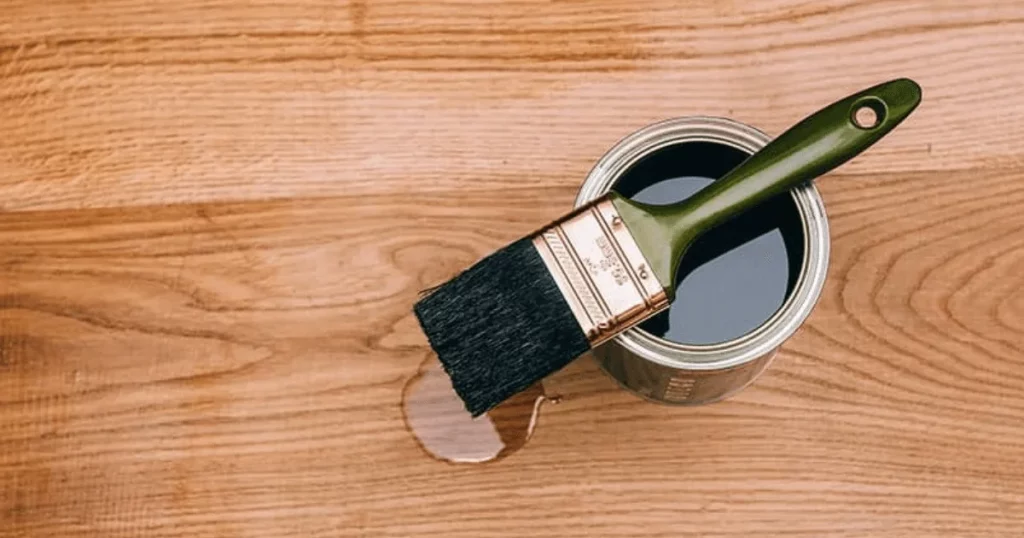
Rubbed and sprayable polyurethane
This type of polyurethane has several special features, firstly – an incredibly thin layer of an application. Sprayed and rubbed polyurethane allows you to get an even and thin layer of varnish without additional tools. In this respect, this kind of polyurethane is superior to other types and can be used even by beginners.
To apply rubbed and sprayable polyurethane, it is enough to take a smooth rag. If you have spray polyurethane, however, apply it like paint. Many professional woodworkers use sprayable polyurethane as a final coat, which is applied after the surface treatment with regular polyurethane.
Why polyurethane is considered the best wood glue for the food industry
Having understood the method of application and background information about polyurethane, it is worth answering the main question – is polyurethane safe for the food industry?
Of course, there is a huge number of polyurethane wood glue to which synthetic substances are added. It is strictly forbidden to use such products for food industry products.
However, there is polyurethane non-toxic wood glue that is created specifically for the bonding and processing of wooden products in contact with food. After complete drying, they can be used for cooking and cutting meat with absolutely no harm to the body.
If you are wondering what kind of food-safe glue is suitable for your purposes, the answer is likely to be polyurethane.
Can polyurethane be used for cutting boards?
As already mentioned – polyurethane can be used in the food industry. For cutting boards, aqueous polyurethane is suitable. It has a small number of harmful components, and after drying, they are neutralized.
If you are afraid to experiment with glue for the cutting boards, it is best to ask for help from consultants. However, you should keep in mind that some unscrupulous sellers may offer a product that does not meet your requirements. That is why before the final decision, read the manufacturer’s recommendations, as not all food wood glue will be suitable for cutting boards.
In the case of using polyurethane to upgrade your cutting boards, a minimum toxicity rating is significant. That is, oil-based polyurethane will not be suitable for cutting boards, as it has a variety of toxic additives in its composition.
Remember that even food-grade wood glue should not be in direct contact with food, which means that the cutting boards can only be used when it is completely dry. All strong adhesives have dangerous components in their liquid state that make them unsuitable for use in contact with food. Therefore, do not allow the cutting boards or any other product to be used until the glue is completely dry.
What are the differences between wood glues?
Wood glues differ in many ways. First, they are created for specific tasks, for example, furniture processing. Such glue cannot be a safe substitute for the food industry because it contains many reinforcing additives, which are rarely safe.
Food-safe wood glues stand out for their organic composition. Often, the manufacturer will indicate on the front of the adhesive’s packaging its primary application. This is why wood glues should be double-checked before you buy them so that you don’t end up buying the wrong product for your purpose.
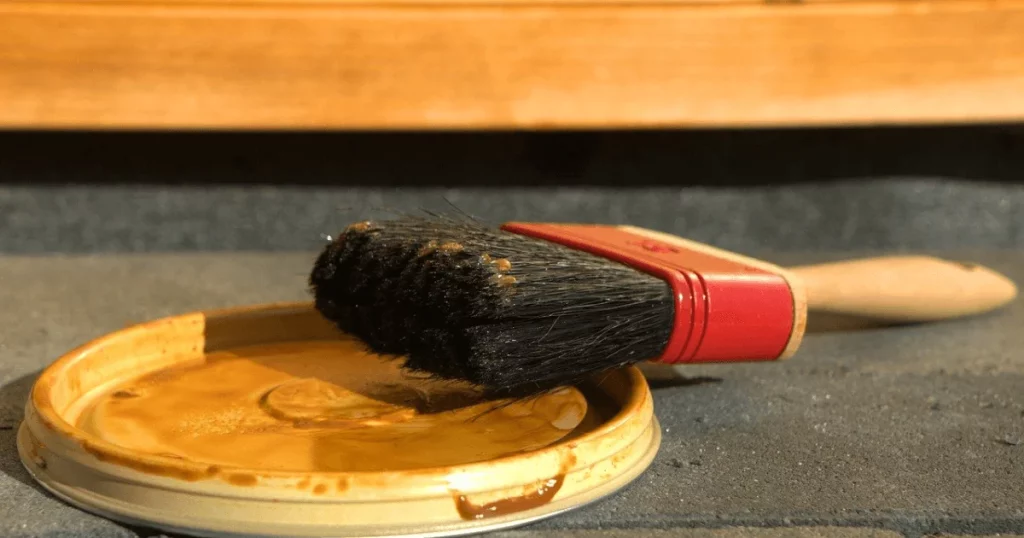
Conclusions
Today, the variety of food-safe glue for wood is incredible, which ultimately complicates the selection process for inexperienced customers. Among all paint coatings, it is polyurethane that is hugely popular in the food industry. It is relatively inexpensive, and its protective properties are superior to alternative coatings.
Polyurethane varnish itself is a resin; hence, it was discovered many decades ago. However, the process does not stand still and today varnish manufacturers offer a huge variety of polyurethane.
Polyurethane has found its application in many areas, but the most popular of them is considered exterior work. This substance can protect the surface from various irritants, including moisture and ultraviolet rays.
The polyurethane market offers water-based and oil-based varnishes. Oil-based polyurethane is quite toxic, leading to a ban in many parts of the United States. However, its effectiveness is superior to the water-based alternative. Of course, the use of such polyurethane is strictly prohibited for bonding food surfaces.
If you have never worked with polyurethane and are afraid of making mistakes during processing, it is better to choose sprayable or wipeable varnish. Their protective properties are the same as a traditional varnish, but the method of application is much easier.
Polyurethane is often used to protect wood because wood species are highly vulnerable to external irritants. This varnish blocks the influence of external factors and, as a result, slows down the aging process of the wooden product.
To remove varnish and wood glue from foodstuffs, you need to choose the right varnish remover.
Answers to popular questions
At the end of this article, let’s break down and discuss popular questions that arise around polyurethane varnish and more specifically its safety for the processing of food products. After reading this part of this guide, working with polyurethane and other coatings will become incredibly simple and routine for you.
Is there a food-safe wood glue?
Many adhesives are safe for indirect food contact. One of the most popular is polyurethane resin. It is incredibly convenient and relatively inexpensive. If you add more specifics, Titebond ultimate wood glue is a great solution.
Is Gorilla Glue wood glue food safe?
Once completely dry, Gorilla Glue is food-safe direct contact. Therefore, it can be used on salad bowls, cutting boards, and kitchen tables.
Can you use wood glue for cutting boards?
Specific wood glue models that are safe for indirect food contact include Titebond III Ultimate Wood Glue and Titebond II Premium Wood Glue. They are suitable for all food processing projects, such as cutting boards.
What brands of glue are food safe?
Krazy Glue® and Rhino Glue are considered safe glues for indirect food contact according to the FDA report. They are both cyanoacrylates and cannot harm humans. Therefore, this glue is suitable for use on cutting boards and other food industry products.
Finally, I would like to draw the attention of every woodworker. The progression of adhesives for wood is very rapid, as a consequence, every year there are new adhesives that are safe for humans. If you need the modernization of food products, then you need to approach this issue carefully.
Excessive savings on wood glue in this case is simply not acceptable. In addition to poor protective properties and short life, you can get a shipment and other health problems.
If your budget is limited, but you want to avoid exposing yourself, your family, or your clients, it is best to choose polyurethane wood glue. This substance meets all the necessary criteria for use on cutting boards and other food industry products.
When buying food-safe glue for wood, always pay attention to the reviews of other buyers, and if you pick up the product directly in a specialized store, be sure to ask the consultant to pick up a particular glue for cutting boards.

My name is Alex Mashinsky
I am an enthusiastic woodworking hobbyist who created topwoodworkingtools.com to provide helpful information and advice to fellow woodworkers.
The goal of the website is to help readers make informed decisions about woodworking tools and materials, with the ultimate aim of ensuring that they achieve the best possible results from their projects.
My main focus is on offering accurate, honest, and well-reasoned opinions and advice to help readers choose the most suitable tools and materials for their particular needs.
